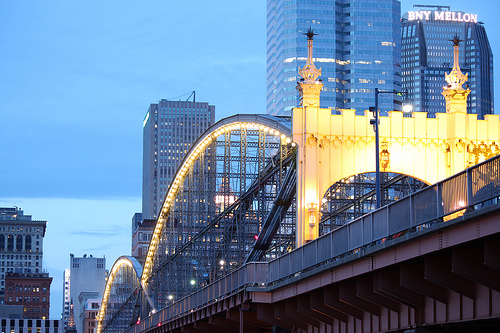Three rivers - the Allegheny, Monongahela, and Ohio - join in Pittsburgh, making the city a natural site for the building of bridges. But the Smithfield Street Bridge stands apart from other Pittsburgh bridges for several reasons: it replaced structures by two well-known bridge engineers, Lewis Wernwag and John A. Roebling; it was the first use in America of the lenticular - or lens-shaped - truss design; and it was one of the first major bridges in the U.S. built primarily with steel.
The Smithfield Street Bridge also is significant because it was designed by the renowned engineer and bridge designer Gustav Lindenthal, who was only 32 years old when he conceived it. The graceful appearance of the bridge's twin 360-foot spans foreshadowed a new approach to bridge-building-when Lindenthal became commissioner of bridges for the city of New York in 1902, he initiated the formal practice of engineers and architects collaborating on all major bridge projects.
Facts
- Lindenthal originally specified Bessemer steel -- made in blast furnaces -- for the Smithfield Street Bridge, but later decided on open-hearth steel, manufactured locally, because it could be made more uniformly and of higher quality. Other bridges for which Lindenthal is known include the Hellgate Bridge over the East River and the Queensborough Bridge, both in New York City.
- The Smithfield Street Bridge was built on piers constructed in 1880 for a previous project that had been planned and then abandoned by the company responsible for the constuction and operation of the bridge. By building on the downstream side of piers and designing a detachable sidewalk on the upstream side, Lindenthal provided for the bridge's eventual expansion from its original 48-foot width.
- In 1889, a second deck was added to the Smithfield Street Bridge to carry horse-drawn streetcars; ten years later, the deck was widened to accommodate electric trolleys. In 1911, the tolls were removed, and in 1915, the original wrought iron portals were replaced with replicas made of cast steel.
- A thorough renovation in 1933 replaced the bridge's steel floor system with structural aluminum beams and prefabricated aluminum decking.
- A second renovation, in 1996, increased the bridge's load limit from three to 23 tons. It also restored the bridge's original color scheme -- including royal-blue trusses and sandstone-yellow portals -- while replacing the six copper finials that crown the elaborately decorated portals.
- Another well-known bridge using the lenticular truss design in a double span is the Saltash Railway Bridge across the River Tamar in Cornwall, England, designed by noted engineer Isambard K. Brunel in the late 1850s.



